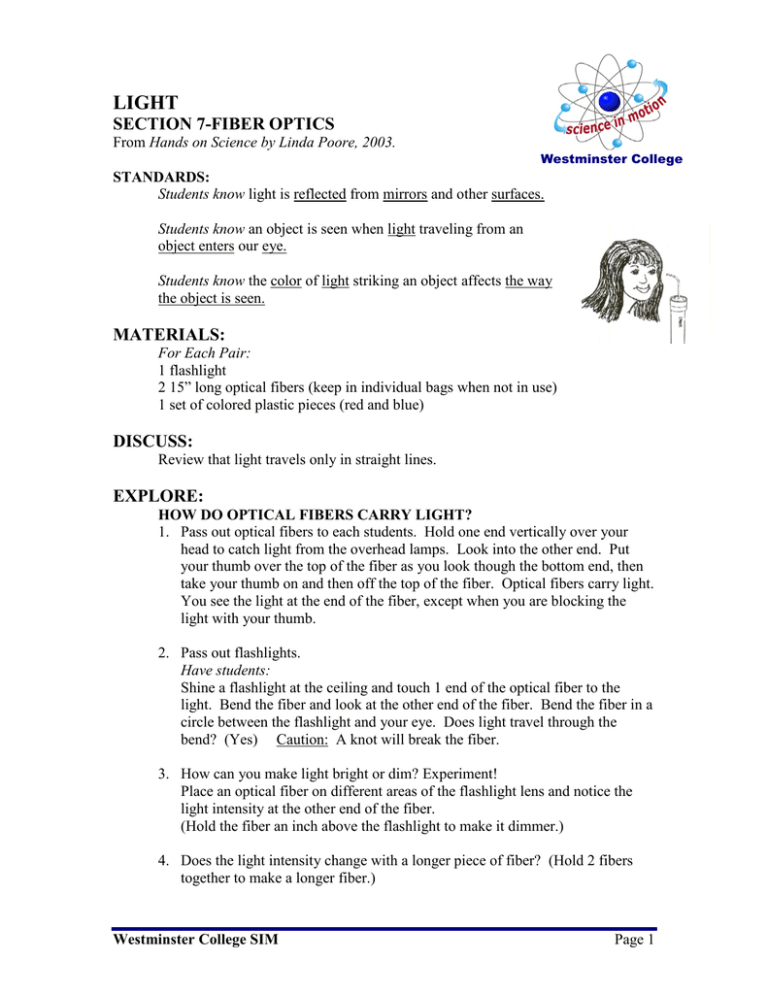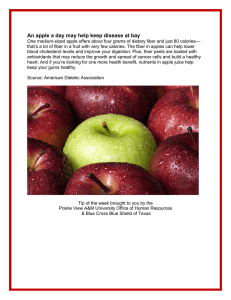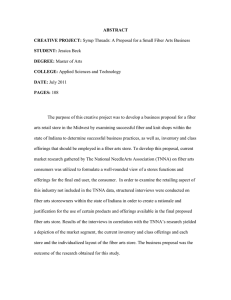LIGHT SECTION 7-FIBER OPTICS MATERIALS:
advertisement

LIGHT SECTION 7-FIBER OPTICS From Hands on Science by Linda Poore, 2003. Westminster College STANDARDS: Students know light is reflected from mirrors and other surfaces. Students know an object is seen when light traveling from an object enters our eye. Students know the color of light striking an object affects the way the object is seen. MATERIALS: For Each Pair: 1 flashlight 2 15” long optical fibers (keep in individual bags when not in use) 1 set of colored plastic pieces (red and blue) DISCUSS: Review that light travels only in straight lines. EXPLORE: HOW DO OPTICAL FIBERS CARRY LIGHT? 1. Pass out optical fibers to each students. Hold one end vertically over your head to catch light from the overhead lamps. Look into the other end. Put your thumb over the top of the fiber as you look though the bottom end, then take your thumb on and then off the top of the fiber. Optical fibers carry light. You see the light at the end of the fiber, except when you are blocking the light with your thumb. 2. Pass out flashlights. Have students: Shine a flashlight at the ceiling and touch 1 end of the optical fiber to the light. Bend the fiber and look at the other end of the fiber. Bend the fiber in a circle between the flashlight and your eye. Does light travel through the bend? (Yes) Caution: A knot will break the fiber. 3. How can you make light bright or dim? Experiment! Place an optical fiber on different areas of the flashlight lens and notice the light intensity at the other end of the fiber. (Hold the fiber an inch above the flashlight to make it dimmer.) 4. Does the light intensity change with a longer piece of fiber? (Hold 2 fibers together to make a longer fiber.) Westminster College SIM Page 1 FIBER OPTICS 5. Can you make different colored light go through the fiber? Experiment. (Students use their shirt, hand, or colored paper on top of the flashlight and hold the optical fiber above the colored light.) 6. Pass out colored plastic pieces and place different colors between the light and the fiber. Experiment with 2 colors together. 7. Wrap colored plastic around the fiber. What color is light? (White) DISCUSS: Have students share their discoveries. How did they make the light dim, bright, colored? What happened when they put two colors together? Light can only go in straight lines. Have them discuss experiments where the light seemed to go in curves through the fiber, instead of straight. EXTENSION: USES OF OPTICAL FIBERS • Light up the inside of the body (stomach, knee, etc.) for surgery. • Send telephone messages (sound is converted to light energy) • Bend light around corners • Provide a cool source of light inside machines, the body, etc. • Direct light to a dental patient’s mouth, not into his eyes! • Bring sunlight into a building to grow plants and as a source of Vitamin D for invalids. ASSESSMENT: Give students the worksheet Fiber Optics at the end of this section. 1. Answers: 1.(see picture on this page) 2. Light is reflected inside fiber, bouncing inside in straight lines as it travels through the fiber. Optical fiber is reflective inside and acts like a mirror. 3. Hold a fiber several inches from light source. 4. Hold a fiber touching the flashlight near the bulb. 5. Insert color between the light and fiber. 6. Answers vary. Westminster College SIM Page 2 FIBER OPTICS Westminster College SIM Page 3







